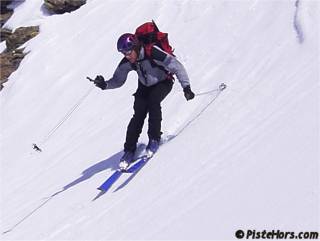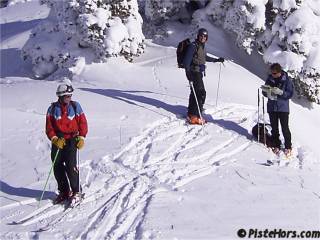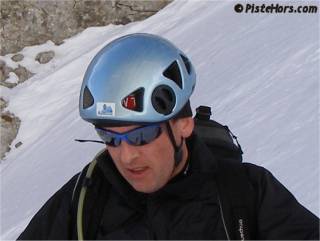
You may have noticed photos where we have been wearing helmets. Now some of the outings we do are really climbing routes where there is a risk of stone fall. This particularly applies to couloirs or any steep slope when the weather gets warm. If you would wear a helmet climbing on feet then you should wear a helmet climbing on skis.

Still unusual in the backcountry
While helmets have, by and large, been accepted for the fun park and are increasingly common on piste they are still rare in the backcountry. Probably less than 5% of ski or snowboard tourers wear them in France. Two helmet wearing friends, Seb and Cyril, see ski touring in the same light as mountain biking. You can fall on hard slopes, there are rocks and a helmet is excellent protection in forest tracks. They have opted for lightweight climbing type helmets, stowing them on their rucksacks for safer parts of the climb. Although similar to ski helmets they offer less side protection compared to ski or snowboard designs; the point where the skull is weakest and vulnerable during tumbling falls.

Maybe we should have taken the GPS option?
Ben and Laurent have opted for ski helmets which they wear both for climbing and descending. Ben says that his helmet is “warm even on cold winter days and you never know when you might need it, zero risk doesn’t exist in the mountains.” Ben has opted for a standard helmet from Decathlon.
Beyond a nice design and extras like Bluetooth or headphones (a bad idea in our opinion) do skiers and boarders really know what they are buying? An article on helmet safety by Clyde Soles says that buying a helmet is one big leap of faith with helmet makers only just complying with either dated or flawed standards such as what he describes as the “worthless” CE 1077 developed in Europe for race helmets in the 1980s.

Petzl Meteor
Most Climbing helmets will comply with the CEN 12492 or the slightly less stringent UIAA standards. These are more concerned with impacts from round and sharp objects as might be encountered climbing. An independent helmet test by the British Mountaineering Council (BMC) gave high marks to the Petzl Meteor, a very popular choice amongst ski mountaineers due to its light weight. The authors of the study recommend buying a helmet that is comfortable as you are more likely to wear it. Their tests suggests that lightweight foam helmets such as the Meteor, while less satisfactory for climbing type use where stone or climbing gear impact is a major problem, give better side, front and rear protection. The kind of impacts you might suffer while skiing. However they guard against using test data designed for one activity for another.
From a consumer viewpoint and given the ever increasing speeds and risk of collisions on piste (the figures for France have doubled to 5% of all injuries in the last decade) and the increasing number of skiers off-piste and in the backcountry it seems that a revision of the European standards is appropriate with possibly separate recommendations for park, pistes and touring.